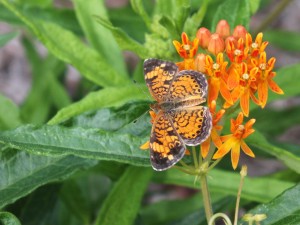by Kristen Minogue

Three nonnative flowers in Maryland. Left to right: Queen Anne’s Lace, Moth Mullein and Lesser Celandine. (Susan Cook-Patton)
“I just want to plant something that will grow in my yard. If a nonnative species grows better than a native, why shouldn’t I plant it?”
It’s a valid question, one that SERC postdoc Susan Cook-Patton remembers hearing from her father while still in high school. In the quest to preserve native plants, it’s become almost taboo to talk about the benefits of nonnatives. But not all nonnative plants are rampant invaders, and sometimes they could be good for gardens as a whole. Cook-Patton broke down the pros and cons of gardening with nonnative species at the Smithsonian Environmental Research Center’s first evening lecture on April 15. Here are a few to consider when deciding what to put in your garden:
Pro: Nonnatives often increase diversity. Diversity is good—in gardens as well as in forests. Plantings with a mixture of species grow better, because they use soil and water more efficiently, and they’re more adept at resisting a blight or invasion. Plant diversity also leads to more animal diversity.
Pro: Nonnatives can “play nice” with others. If you want to enhance growth in your garden, diversity is key. In Cook-Patton’s experiments, it did not matter if the community was all native or nonnative: Diverse plots grew more profusely than single-species plots of either one. But diverse plots of exclusively exotic plants saw the most growth.
Con: Nonnatives can suppress seeds of natives. Mixing natives and exotics may not kill the current native plants, but they could stifle the next generation. When nonnative plants mingled with natives, the natives produced fewer seeds. But this was only relative to diverse native plots—native plants still produced more seeds when mixed with nonnatives than a single native species by itself.
Con: Nonnative plants recruit fewer insects. If you want a butterfly garden, you’re better sticking with the natives. Goldenrod recruits more than 100 species of butterflies and moths, and sunflowers are popular rest stops as well.
When planning out your garden beds, consider intermingling species to enhance their vigor, and use a diverse mix of species to improve the overall health of your garden. There are many beautiful native species to choose among. But if you decide to plant nonnatives in the mix, make sure they’re good neighbors and not harmful invasives.



These are beautiful flowers, I would really like to grow some of these, thank you for sharing!